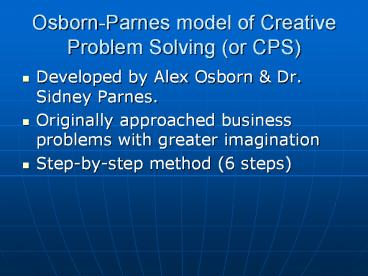Osborn-Parnes model of Creative Problem Solving (or CPS) - PowerPoint PPT Presentation
1 / 14
Title:
Osborn-Parnes model of Creative Problem Solving (or CPS)
Description:
Osborn-Parnes model of Creative Problem Solving (or CPS) Developed by Alex Osborn & Dr. Sidney Parnes. Originally approached business problems with greater imagination – PowerPoint PPT presentation
Number of Views:424
Avg rating:3.0/5.0
Title: Osborn-Parnes model of Creative Problem Solving (or CPS)
1
Osborn-Parnes model of Creative Problem Solving
(or CPS)
- Developed by Alex Osborn Dr. Sidney Parnes.
- Originally approached business problems with
greater imagination - Step-by-step method (6 steps)
2
- OFPISA
- Objective Finding
- Fact Finding
- Problem Finding
- Idea Finding
- Solution Finding
- Acceptance Finding
3
- In each of the 6 steps students are required to
repeat the brainstorm and select process - The students need to focus on divergent thinking,
then convergent thinking - Each step forms the creative foundation for the
next step.
4
Step 1 Objective Finding
- Narrow focus of the problem
- Diverge for concerns, challenges
5
Step 2 Fact Finding
- Collect all relevant information related to the
problem
6
Step 3 Problem Finding
- Rephrasing the problem to one which makes more
solutions - In What Ways Might We
7
Step 4 Idea Finding
- List all possible ideas that might be solutions
to the problem - A brainstorming step
8
Step 5 Solution Finding
- Diverging and converging thinking process
- Evaluate the ideas with the greatest potential
- Evaluation criteria evidence-based, scientific,
practical, cost-effective
9
Step 6 Acceptance Finding
- Consensus on the action plans
- 5Ws and H checklist
- (Who, What, When, Why, Where, How much, How long)
10
Reference
- http//www.ctp.bilkent.edu.tr/cte206/cps.pdf
- http//www.m1creativity.co.uk/cps.htm
11
Discover Curriculum Model(June Maker)
- Developing students strengths and creativity
through varied opportunities for real-world
problem solving
12
- http//discover.arizona.edu/problem_solving.htm
13
- Type 1 The problem is simple, closed, and known
to both the presenter and the solver. The
method, also, is known to the presenter and to
the solver. The solution is known to the
presenter but must be derived by the solver. - Example Solve 3 4. The problem is clearly
defined. The method is addition, and the solver
need only determine that 7 is the correct
answer.
14
- Type 5 The problem(s), method(s), and
solution(s)all of which are completely
open-ended and complexare ill defined, for both
the presenter and the solver.































